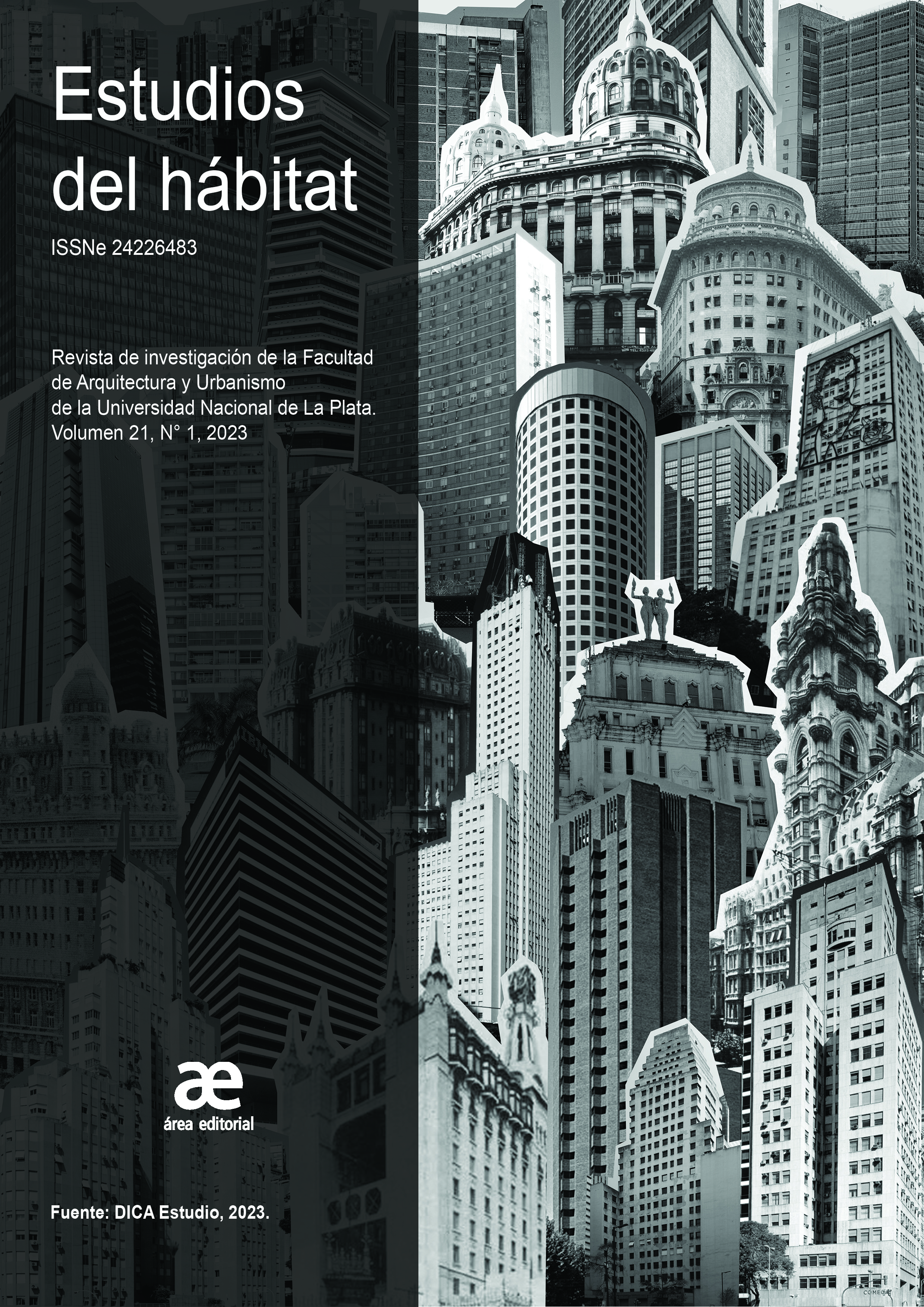Dossier: High-rise construction in the Americas between the 19th and 20th centuries
Projects, images, visions and utopias
Keywords:
high-rise Construction , Americas, history of architectureAbstract
As the 19th century came to an end, a new architectural type—later known as skyscraper—emerged in the United States, particularly in Chicago and New York. The technical possibilities and cultural aspirations associated with this type rapidly gained a prominent place in the debates and professional practice of architects, urban planners, and engineers around the globe. The fascination with skyscrapers attracted a much wider audience, so that they soon became symbols of modern times. As such, skyscrapers were part of a global imaginary of utopian projects and fantasies, along with airplanes, elevators, reinforced concrete structures and elevated streets and railways. Both images and projects casted these visions of the future and were disseminated not only in professional circles but also in popular magazines, books, and movies. The ideal of the modern metropolis was then represented by the skyscraper, that materialized the “American dream”. In this context, Buenos Aires, Sao Paulo, Río de Janeiro, and Montevideo were the few cities outside the United States where skyscrapers were built during the first three decades of the 20th century. As part of a broader research project, this dossier intends to be a contribution to high-rise construction studies. The aim is to fill in areas of vacancy in fields ranging from the history of architecture and visual culture to the history of construction techniques. The selected articles focus on different aspects of this topic, covering the entire 20th century.
Downloads
Metrics
References
Aboy, R. (2005). Viviendas para el pueblo. Espacio urbano y sociabilidad en el barrio Los Perales, 1946-1955. FCE.
Ancell, C. (1924). La biblia de piedra. Estudios de estética arquitectónica. Porter.
Bergere, T. y R. (1965). From stones to skyscrapers: A book about architecture. E.M. Hale.
Birkmire, W. (1893). Skeleton construction in buildings: With numerous practical illustrations of high buildings. J. Wiley & Sons.
Birkmire, W. (1898). The planning and construction of high office-buildings. Wiley, J. & Sons.
Bonicatto, V. (2011). Escribir en el cielo. Relatos sobre los primeros rascacielos en Buenos Aires 1907-1929, [Tesis de Maestría, Buenos Aires. Universidad Torcuato Di Tella].
Bonicatto, V. (2017). Necesidad simbólica y realidad material. Arquitectura terciaria en Buenos Aires. 1907-1934. Registros. Revista de Investigación Histórica, 13 (2), 5-30.
Ciucci, G., Dal Co, F., Manieri, E. y Tafuri, M. (1973) La ciudad americana: de la guerra civil al New Deal. GG.
Cohen, J. L. (1995). Scenes of the world to come: European architecture and the American challenge 1893-1960. Centre Canadien d' Architecture.
Condit, C. (1973). The Chicago School of Architecture: a History of Commercial and Publica Building in the Chicago Area, 1875-1925. University of Chicago Press.
Condit, C. (2003), The Rise of the Skyscraper. Textbook Publishers.
Contreras, L. (2005). Rascacielos porteños. Historia de la edificación en altura en Buenos Aires (1580- 2005). Gobierno de la Ciudad.
Fara, C. (2020). Un horizonte vertical. Paisaje urbano de Buenos Aires (1910-1936). Ampersand.
Freitag, J. K. (1901). Architectural engineering: with special reference to high building construction, including many examples of prominent office buildings. J. Wiley & sons.
Garmendia, M. (2007). Atlas de torres. Nobuko.
Gorelik, A. (2011). Historias de Nueva York. Arquitectura, capitalismo y pensamiento crítico en Delirious New York”. Block (8).
Gravagnuolo, B. (1998). Historia del urbanismo en Europa 1750-1960. Akal.
Gutman, M. (2011). Buenos Aires. El poder de la anticipación. Infinito.
Iglesia, R. (1979). El 29: espejo de la arquitectura.Revista Nuestra Arquitectura , (513-14), 65-88.
Iglesia, R. (1965). El fenómeno del rascielos. Revista Nuestra Arquitectura , (427), 29-40.
Koolhaas, R. (1994). Delirious New York: A retroactive manifesto for Manhattan Monacelli Press.
Liernur, J. F. (1980). Rascacielos en Buenos Aires. Revista Nuestra Arquitectura, (511-512), 75-88.
Liernur, J. F (2001). Arquitectura en la Argentina del siglo XX. La construcción de la modernidad. Fondo Nacional de las Artes.
Liernur, J. F (2001). Arquitectura, en teoría. Nobuko.
Liernur, J. F (2004). Rascacielos. En J. Liernur y F. Aliata (eds), Diccionario de Arquitectura (pp. 144-148). Clarín.
Manieri E. M. (1985). Las investigaciones del Instituto de Historia de la Arquitectura de Venecia sobre los EE.UU. Materiales, (5).
Mujica, F. (1929). History of the Skyscraper. Archaeology & Architecture Press.
Mumford, L. (1971). The Brown Decades: A study of the arts in America, 1865-1895. Dover.
Neumann, D. (1995). Die Wolkenkratzer kommen! deutsche Hochhäuser der zwanziger Jahre: Debatten, Projekte, Bauten. Braunsch. Vieweg.
Quintana de Uña, J. (2006). Sueño y frustración. El rascacielos en Europa. 1900-1939. Alianza.
Robbin, I. (1963). The how and why wonder book of caves to skyscrapers. Grosset & Dunlap.
Schuyler, M. (1961). American Architecture and other writings. (Vol. I-II). Harvard University Press.
Solari, C. (2020). Rafael Iglesia. Lecturas en la construcción de una poética. Diseño.
Tafuri, M. (1976). Architecture and utopia: design and capitalist development. MIT Press.
Tafuri, M (1984). La esfera y el laberinto. De Piranesi a los años setenta. GG.
Webster, C. (1959). The Skyscrper: Logical and Historical Considerations. Journal of the Society of Architectural Historians, 17(4).
Weisman, W. (1953). New York and the problem of the first Skyscraper. Journal of the Society of Architectural Historians, 12(1), 13–21.
Downloads
Published
How to Cite
Issue
Section
License
Copyright (c) 2023 Dra. Arq. Virginia Bonicatto, Dra. Catalina Fara, Dr. Sebastían Malecki

This work is licensed under a Creative Commons Attribution-NonCommercial-NoDerivatives 4.0 International License.
Acorde a estos términos, el material se puede compartir (copiar y redistribuir en cualquier medio o formato) y adaptar (remezclar, transformar y crear a partir del material otra obra), siempre que a) se cite la autoría y la fuente original de su publicación (revista y URL de la obra), b) no se use para fines comerciales y c) se mantengan los mismos términos de la licencia.








.jpg)

















